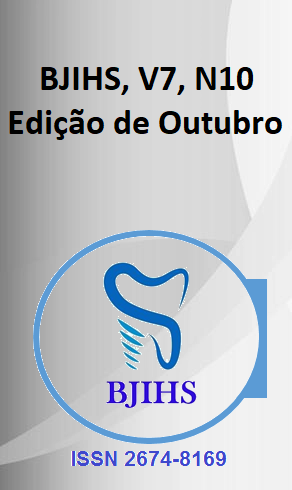Abstract
This study addresses the risks associated with unnecessary exposure to ionizing radiation in pediatric patients, with a special focus on dental practice. Through a literature review, the main radiation sources used in children were analyzed, such as intraoral radiographs, panoramic radiographs, cephalometric radiographs, and cone-beam computed tomography (CBCT). Due to the greater radiosensitivity of pediatric tissues and their long-life expectancy, adverse effects, both immediate and late, such as mutations and cancer, become more relevant in this population. The study highlights the importance of applying the ALARA (As Low As Reasonably Achievable) principle, reinforcing the need for justified examinations, the use of appropriate technologies, and professional training. It is concluded that radiation protection in children should be an ethical and clinical priority, always seeking to minimize risks without compromising diagnostic efficacy.
References
Lacerda MAS, Silva TA, Khoury HJ, et al. Riscos dos exames radiográficos em recém-nascidos internados em um hospital público de Belo Horizonte, MG. Radiol Bras. 2008;41:325–9.
International Commission on Radiological Protection. Recommendations of the International Commission on Radiological Protection. ICRP Publication 60. New York: Pergamon Press; 1991.
Oliveira ML, Khoury H. Influência do procedimento radiográfico na dose de entrada na pele de pacientes em raios-X pediátricos. Radiol Bras. 2003;36(2):105–9.
Instituto Federal de Santa Catarina. Wiki.sj.ifsc.edu.br/wiki/index.php/ICO60801_-_Diário_2016-2. Disponível em: http://www.sobiologia.com.br/conteudos/oitava_serie/Ondas4.php. [Acesso em 20 fev. 2017].
Hedesiu M, Marcu M, Salmon B, Pauwels R, Oenning AC, Almasan O, et al. Irradiação fornecida por procedimentos radiológicos odontológicos em uma população pediátrica. Eur J Radiol. 2018;103:112–7. doi:10.1016/j.ejrad.2018.04.021.
Preston RJ. Radiation biology: concepts for radiation protection. Health Phys. 2005;88(6):545–56.
Gerber TC, Gibbons RJ. Weighing the risks and benefits of cardiac imaging with ionizing radiation. JACC Cardiovasc Imaging. 2010;3(5):528–35.
Mastrocola LE, Alves FBP, Lopes RW. Exames de imagem e risco da exposição às radiações. Conceitos fundamentais. Parte I. Rev DERC. 2012;18(2):44–5.
Skromov de Albuquerque A, Mastrocola LE. Radiação e exames diagnósticos: qual o risco real. Rev Soc Cardiol Estado São Paulo. 2017;27(2):82–7.
Einstein AJ. Effects of radiation exposure from cardiac imaging: how good is the data? J Am Coll Cardiol. 2012;59(6):553–65.
Guibelalde E, Fernández JM, Vanó E, Llorca A, Ruiz MJ. Image quality and patient dose for different screen-film combinations. Br J Radiol. 1994;67:166–73.
Preston DL, Shimizu Y, Pierce DA, Sobue T, Fujita S, et al. Solid cancer incidence in atomic bomb survivors: 1958–1998. Radiat Res. 2007;168:1–64.
Agarwal P, Vinuth DP, Haranal S, et al. Genotoxic and cytotoxic effects of X-ray on buccal epithelial cells following panoramic radiography: a pediatric study. J Cytol. 2015;32(2):102–6. doi:10.4103/0970-9371.160559.

This work is licensed under a Creative Commons Attribution 4.0 International License.
Copyright (c) 2025 Amanda Karoliny Melo de Brito, Eric Felipe Silva Gomes, Gabriel de Assis Bandeira Sousa, Lívia Maria Santana de Siqueira , Maria Alice Vieira dos Santos, Maria Clara Fernanda Melo de Brito, Samnyo Martins Oliveira

